Principaux résultats
Date de dernière mise à jour des résultats : 23/08/2013
- L’environnement alimentaire et le statut socio-économique influent sur les taux d’obésité à Seattle et à Paris
- L’accessibilité spatiale aux équipements sportifs et la pratique sportive
- Relations entre une typologie de quartiers et la pression artérielle
- Multiples caractéristiques des quartiers de résidence et pratique du jogging
- Enseignes et caractéristiques des supermarchés et excès de poids et de graisses abdominales
- Environnements physique, de services et social : quelles associations avec la corpulence et le tour de taille ?
- Les disparités sociales d’exposition résidentielle au bruit routier : une étude de justice environnementale
- Déterminants individuels et contextuels de la participation à la Cohorte RECORD : identification et correction des biais induits
- Associations entre niveau socio-économique du quartier de résidence et pression artérielle : rôle du poids et de la fréquence cardiaque comme mécanismes explicatifs ?
- Les disparités d’obésité en Île-de-France : une influence massive du niveau socio-économique du quartier de résidence
- Les conditions de vie contrastées des quartiers d’Île-de-France : le quartier comme source de stress ?
L’environnement alimentaire et le statut socio-économique influent sur les taux d’obésité à Seattle et à Paris
Objectifs de l'étude : Lien vers l'étude concernée
Date de diffusion : 08/2013
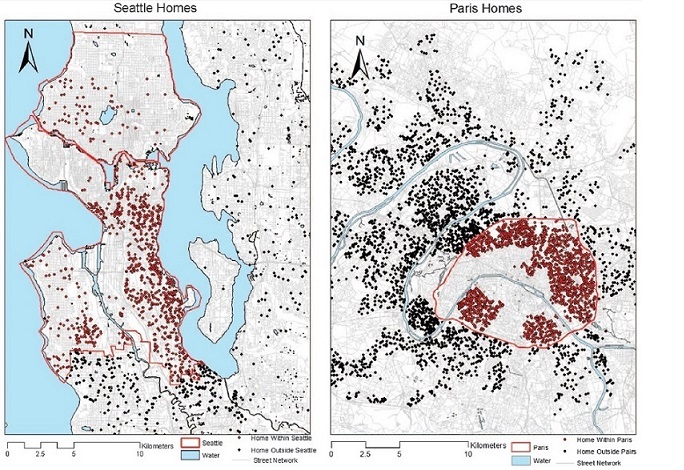 L’objectif était de comparer les associations entre l’environnement alimentaire appréhendé au niveau individuel, le niveau socio-économique et les taux d’obésité dans deux villes : Seattle et Paris. Les analyses de la « Seattle Obesity Study » (SOS) s’appuyaient sur un échantillon représentatif de 1340 adultes des Comtés de Seattle et de King. Les analyses à partir de la Cohorte RECORD concernaient un échantillon de 7131 adultes de Paris et de la région parisienne. La distance à parcourir jusqu’au supermarché utilisé n’était pas associée au risque d’obésité dans les deux études. Par contre, un faible niveau d’instruction et de faibles revenus, une faible valeur des biens immobiliers à proximité du logement et le fait de faire ses courses dans un supermarché hard discount étaient associés à un risque d’obésité plus élevé dans les deux échantillons.
L’objectif était de comparer les associations entre l’environnement alimentaire appréhendé au niveau individuel, le niveau socio-économique et les taux d’obésité dans deux villes : Seattle et Paris. Les analyses de la « Seattle Obesity Study » (SOS) s’appuyaient sur un échantillon représentatif de 1340 adultes des Comtés de Seattle et de King. Les analyses à partir de la Cohorte RECORD concernaient un échantillon de 7131 adultes de Paris et de la région parisienne. La distance à parcourir jusqu’au supermarché utilisé n’était pas associée au risque d’obésité dans les deux études. Par contre, un faible niveau d’instruction et de faibles revenus, une faible valeur des biens immobiliers à proximité du logement et le fait de faire ses courses dans un supermarché hard discount étaient associés à un risque d’obésité plus élevé dans les deux échantillons.
http://www.record-study.org/images/record/upload/publications/IJO_RECORD-SOS.pdf
L’accessibilité spatiale aux équipements sportifs et la pratique sportive
Objectifs de l'étude : Lien vers l'étude concernée
Date de diffusion : 03/2013
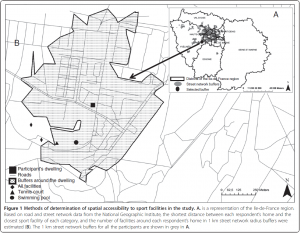 Le but de cette étude était d’investiguer les associations existant entre l’accessibilité spatiale à des types d’équipements sportifs spécifiques et la pratique des sports correspondants, après avoir tenu compte de différentes caractéristiques socio-économiques individuelles et contextuelles. Un niveau d’instruction élevé et un niveau élevé de revenus du ménage étaient associés à la pratique de sports de raquettes, à la natation et à des activités de piscine, et à la pratique du fitness au cours des 7 jours précédents. L’accessibilité spatiale à une piscine étaient associée à la pratique de la natation et de sports de piscine, même après avoir tenu compte des facteurs socio-économiques individuels et contextuels. L’accessibilité spatiale aux équipements n’était pas associée à la pratique des autres sports examinés. Un niveau de revenus élevé au sein du quartier était associé à la pratique de sports de raquettes et de fitness.
Le but de cette étude était d’investiguer les associations existant entre l’accessibilité spatiale à des types d’équipements sportifs spécifiques et la pratique des sports correspondants, après avoir tenu compte de différentes caractéristiques socio-économiques individuelles et contextuelles. Un niveau d’instruction élevé et un niveau élevé de revenus du ménage étaient associés à la pratique de sports de raquettes, à la natation et à des activités de piscine, et à la pratique du fitness au cours des 7 jours précédents. L’accessibilité spatiale à une piscine étaient associée à la pratique de la natation et de sports de piscine, même après avoir tenu compte des facteurs socio-économiques individuels et contextuels. L’accessibilité spatiale aux équipements n’était pas associée à la pratique des autres sports examinés. Un niveau de revenus élevé au sein du quartier était associé à la pratique de sports de raquettes et de fitness.
http://www.record-study.org/images/record/upload/publications/IJBNPA_equisport.pdf
Relations entre une typologie de quartiers et la pression artérielle
Objectifs de l'étude : Lien vers l'étude concernée
Date de diffusion : 03/2013
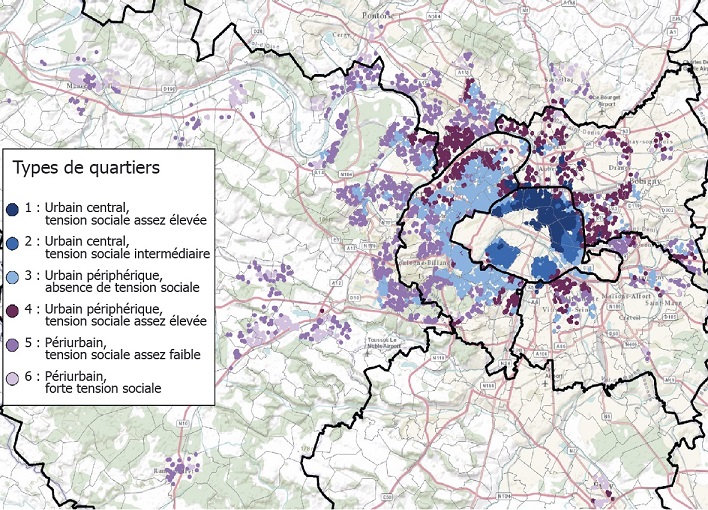 Les études passées sur les associations entre les quartiers de vie et la pression artérielle se sont souvent appuyées sur des caractérisations imprécises des quartiers. La présente étude s’est intéressée aux associations entre une typologie de quartiers basée sur de nombreuses caractéristiques des quartiers résidentiels et la pression artérielle systolique et diastolique.
Six types de quartiers contrastés ont été identifiés et étudiés en relation à la pression artérielle systolique et diastolique. La typologie incluait des quartiers allant de la banlieue à l’urbain central, avec des niveaux différents de dégradation des interactions sociales.
Une association a été documentée entre le fait d’habiter dans un quartier urbain défavorisé et la pression artérielle systolique. Cette association était encore apparente après avoir tenu compte des caractéristiques socio-économiques individuelles et des quartiers et de facteurs de risque de l’hypertension artérielle. Différemment, une relation inverse a été observée entre le degré d’urbanicité des quartiers et la pression artérielle diastolique, même après avoir tenu compte de facteurs de risque de l’hypertension.
Les études passées sur les associations entre les quartiers de vie et la pression artérielle se sont souvent appuyées sur des caractérisations imprécises des quartiers. La présente étude s’est intéressée aux associations entre une typologie de quartiers basée sur de nombreuses caractéristiques des quartiers résidentiels et la pression artérielle systolique et diastolique.
Six types de quartiers contrastés ont été identifiés et étudiés en relation à la pression artérielle systolique et diastolique. La typologie incluait des quartiers allant de la banlieue à l’urbain central, avec des niveaux différents de dégradation des interactions sociales.
Une association a été documentée entre le fait d’habiter dans un quartier urbain défavorisé et la pression artérielle systolique. Cette association était encore apparente après avoir tenu compte des caractéristiques socio-économiques individuelles et des quartiers et de facteurs de risque de l’hypertension artérielle. Différemment, une relation inverse a été observée entre le degré d’urbanicité des quartiers et la pression artérielle diastolique, même après avoir tenu compte de facteurs de risque de l’hypertension.
Multiples caractéristiques des quartiers de résidence et pratique du jogging
Objectifs de l'étude : Lien vers l'étude concernée
Date de diffusion : 04/2012
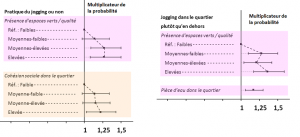 L’étude a été publiée dans Preventive Medicine. L’objectif de cette étude était d’examiner les associations entre un grand nombre de caractéristiques environnementales et la pratique du jogging, en prenant en compte de différentes variables réponse complémentaires pour décrire la pratique du jogging. La présence d’espaces verts et ouverts et leur qualité étaient associées à une probabilité plus élevée de jogger et au fait de jogger à l’intérieur de son quartier de résidence plutôt qu’en dehors. De plus, un niveau élevé de cohésion sociale et la présence d’endroits agréables étaient associés à une probabilité plus élevée de jogger, alors que la surface mesurée d’espaces verts et la présence d’une pièce d’eau augmentaient les chances de jogger à l’intérieur de son quartier.
L’étude a été publiée dans Preventive Medicine. L’objectif de cette étude était d’examiner les associations entre un grand nombre de caractéristiques environnementales et la pratique du jogging, en prenant en compte de différentes variables réponse complémentaires pour décrire la pratique du jogging. La présence d’espaces verts et ouverts et leur qualité étaient associées à une probabilité plus élevée de jogger et au fait de jogger à l’intérieur de son quartier de résidence plutôt qu’en dehors. De plus, un niveau élevé de cohésion sociale et la présence d’endroits agréables étaient associés à une probabilité plus élevée de jogger, alors que la surface mesurée d’espaces verts et la présence d’une pièce d’eau augmentaient les chances de jogger à l’intérieur de son quartier.
http://www.record-study.org/images/record/upload/publications/Prev_Med_Jogging.pdf
Enseignes et caractéristiques des supermarchés et excès de poids et de graisses abdominales
Objectifs de l'étude : Lien vers l'étude concernée
Date de diffusion : 06/2011
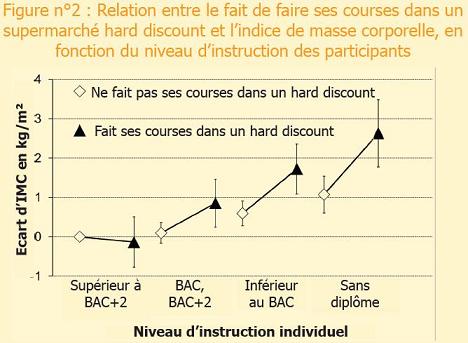
Environnements physique, de services et social : quelles associations avec la corpulence et le tour de taille ?
Objectifs de l'étude : Lien vers l'étude concernée
Date de diffusion : 06/2011
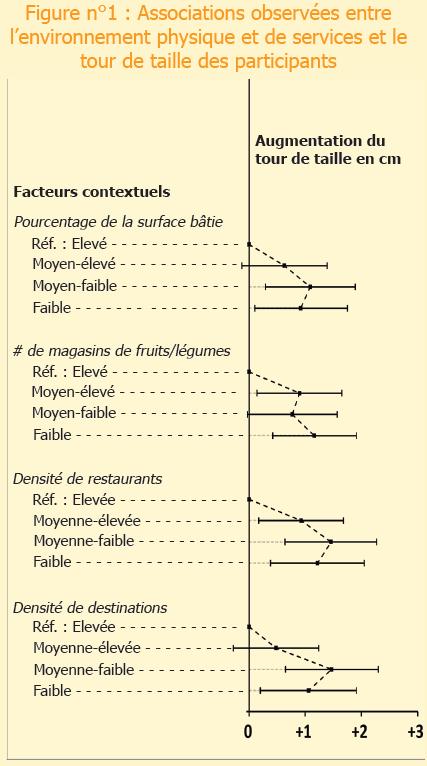
Les disparités sociales d’exposition résidentielle au bruit routier : une étude de justice environnementale
Objectifs de l'étude : Lien vers l'étude concernée
Date de diffusion : 11/2010
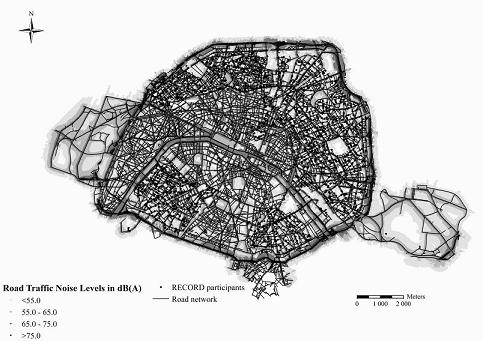 Le bruit lié au trafic routier représente aujourd’hui une des premières nuisances environnementales à laquelle les populations urbaines sont exposées. L’exposition au bruit est susceptible d’affecter la santé et le bien-être au travers d’effets physiologiques (lésions auditives, pathologies cardiovasculaires, troubles du sommeil, etc.) et psychologiques (gêne ressentie, pathologies psychiatriques, troubles du comportement, etc.). Ce risque environnemental pourrait également contribuer aux inégalités sociales de santé via une exposition inégale entre les groupes socio-économiques. Si la problématique de l’injustice environnementale a été largement explorée en matière d’exposition à la pollution atmosphérique, peu d’études se sont en revanche intéressées aux inégalités sociales d’exposition au bruit environnemental, notamment à celui induit par le trafic routier. A partir des données de l’Observatoire du bruit de la Ville de Paris appariées à la Cohorte RECORD, l’objectif de cette étude était d’explorer si les populations socialement défavorisées expérimentent dans leur quartier de résidence des niveaux d’exposition plus élevés que les populations socialement favorisées. En cohérence avec le concept d’injustice environnementale, nous avons mis en évidence des disparités sociales dans l’exposition résidentielle au bruit routier sur la Ville de Paris. Cependant, contrairement aux précédentes études, nous avons montré que les populations vivant dans les quartiers socialement favorisés (définis d’après le niveau d’étude des résidents, la valeur des biens immobiliers du quartier, et la nationalité des résidents) étaient susceptibles d’être exposées dans leur quartier de résidence à des niveaux de bruit routier plus élevés que les individus vivant dans les quartiers socialement défavorisés. Ces résultats étaient cohérents avec la distribution spatiale des niveaux de bruit routier observés sur la Ville de Paris où les principales artères bruyantes de circulation sont localisées aux abords des quartiers d’affaires et touristiques de la capitale, considérés comme favorisés (voir la figure). Par ailleurs, nous avons également mis en évidence une sensibilité de nos résultats à la définition des caractéristiques socio-économiques considérées, en particulier la nationalité des résidents des quartiers. En effet, en considérant la proportion de résidents de nationalité étrangère au sein du quartier, nous avons observé une association apparemment opposée à celles identifiées avec le niveau d’étude et la valeur des biens immobiliers, à savoir une exposition résidentielle au bruit routier plus élevée pour les individus vivant dans les quartiers avec une plus forte proportion d’étrangers. Cependant, quand nous avons redéfini la variable de nationalité en tenant compte du niveau de développement humain des pays, nous avons trouvé, de façon cohérente avec les autres associations, que l’exposition au bruit augmentait à mesure que la proportion d’étrangers de pays développés dans le quartier augmentait et que la proportion d’étrangers de pays sous-développés diminuait. Ces résultats suggèrent 1) qu’il est nécessaire de rester prudent quant à l’interprétation de résultats préliminaires ; et 2) qu’il est important de conduire de façon systématique des analyses de sensibilité avec différentes caractéristiques socio-économiques afin d’éviter de conclure à tort à la présence ou à l’absence d’une situation d’injustice environnementale.
Le bruit lié au trafic routier représente aujourd’hui une des premières nuisances environnementales à laquelle les populations urbaines sont exposées. L’exposition au bruit est susceptible d’affecter la santé et le bien-être au travers d’effets physiologiques (lésions auditives, pathologies cardiovasculaires, troubles du sommeil, etc.) et psychologiques (gêne ressentie, pathologies psychiatriques, troubles du comportement, etc.). Ce risque environnemental pourrait également contribuer aux inégalités sociales de santé via une exposition inégale entre les groupes socio-économiques. Si la problématique de l’injustice environnementale a été largement explorée en matière d’exposition à la pollution atmosphérique, peu d’études se sont en revanche intéressées aux inégalités sociales d’exposition au bruit environnemental, notamment à celui induit par le trafic routier. A partir des données de l’Observatoire du bruit de la Ville de Paris appariées à la Cohorte RECORD, l’objectif de cette étude était d’explorer si les populations socialement défavorisées expérimentent dans leur quartier de résidence des niveaux d’exposition plus élevés que les populations socialement favorisées. En cohérence avec le concept d’injustice environnementale, nous avons mis en évidence des disparités sociales dans l’exposition résidentielle au bruit routier sur la Ville de Paris. Cependant, contrairement aux précédentes études, nous avons montré que les populations vivant dans les quartiers socialement favorisés (définis d’après le niveau d’étude des résidents, la valeur des biens immobiliers du quartier, et la nationalité des résidents) étaient susceptibles d’être exposées dans leur quartier de résidence à des niveaux de bruit routier plus élevés que les individus vivant dans les quartiers socialement défavorisés. Ces résultats étaient cohérents avec la distribution spatiale des niveaux de bruit routier observés sur la Ville de Paris où les principales artères bruyantes de circulation sont localisées aux abords des quartiers d’affaires et touristiques de la capitale, considérés comme favorisés (voir la figure). Par ailleurs, nous avons également mis en évidence une sensibilité de nos résultats à la définition des caractéristiques socio-économiques considérées, en particulier la nationalité des résidents des quartiers. En effet, en considérant la proportion de résidents de nationalité étrangère au sein du quartier, nous avons observé une association apparemment opposée à celles identifiées avec le niveau d’étude et la valeur des biens immobiliers, à savoir une exposition résidentielle au bruit routier plus élevée pour les individus vivant dans les quartiers avec une plus forte proportion d’étrangers. Cependant, quand nous avons redéfini la variable de nationalité en tenant compte du niveau de développement humain des pays, nous avons trouvé, de façon cohérente avec les autres associations, que l’exposition au bruit augmentait à mesure que la proportion d’étrangers de pays développés dans le quartier augmentait et que la proportion d’étrangers de pays sous-développés diminuait. Ces résultats suggèrent 1) qu’il est nécessaire de rester prudent quant à l’interprétation de résultats préliminaires ; et 2) qu’il est important de conduire de façon systématique des analyses de sensibilité avec différentes caractéristiques socio-économiques afin d’éviter de conclure à tort à la présence ou à l’absence d’une situation d’injustice environnementale.
http://www.record-study.org/images/record/upload/OEM_published.pdf
Déterminants individuels et contextuels de la participation à la Cohorte RECORD : identification et correction des biais induits
Objectifs de l'étude : Lien vers l'étude concernée
Date de diffusion : 11/2010
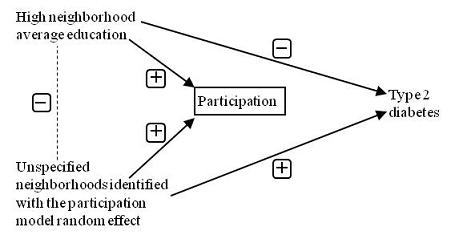 Dans la littérature sur les effets des quartiers de résidence sur la santé, les études de cohorte utilisées pour étudier de telles associations sont sujettes à un certain nombre de biais, notamment à ceux liés à la participation sélective aux études, qui sont susceptibles de distordre les associations estimées entre expositions environnementales et variables de santé. Dans cette étude, notre premier objectif était de développer un modèle compréhensif des déterminants contextuels de la participation des populations à l’Etude RECORD. Notre second objectif était d’examiner dans quelle mesure les effets des caractéristiques des quartiers sur la participation à l’étude étaient susceptibles de biaiser les associations qui nous intéressent entre caractéristiques socio-économiques des quartiers et prévalence du diabète de type 2.
Globalement, le taux de participation à l’Etude RECORD était beaucoup plus élevé pour les populations qui avaient un niveau d’instruction élevé. Après ajustement, le taux de participation était plus faible pour les personnes qui habitaient loin des centres d’examen. La participation à l’étude était par contre plus importante pour les résidents des quartiers où le niveau de revenu médian était élevé et où les prix des biens immobiliers étaient élevés. Quant à l’environnement physique, nous avons observé des taux de participation à l’Etude RECORD plus élevés dans les quartiers où le pourcentage de la surface qui est bâtie était faible et où la hauteur moyenne des bâtiments était faible. Des analyses complémentaires ont confirmé que la distance aux centres et les indicateurs socio-économiques et de densité étaient associés au fait de se rendre aux centres de santé pour y passer un examen, mais n’étaient pas associés (ou très faiblement) avec le taux de participation à l’étude parmi les personnes qui étaient présentes aux centres d’examen.
Nous intéressant aux associations entre variables socio-économiques et diabète de type 2, nous avons trouvé que les variations géographiques du taux de participation à l’étude étaient associées à la prévalence du diabète. Nous avons montré qu’il était possible de corriger le biais qui en résulte pour l’association entre niveau d’instruction moyen du quartier et diabète au travers de la modélisation conjointe des déterminants contextuels de la participation à l’étude et des déterminants contextuels du diabète de type 2.
Dans la littérature sur les effets des quartiers de résidence sur la santé, les études de cohorte utilisées pour étudier de telles associations sont sujettes à un certain nombre de biais, notamment à ceux liés à la participation sélective aux études, qui sont susceptibles de distordre les associations estimées entre expositions environnementales et variables de santé. Dans cette étude, notre premier objectif était de développer un modèle compréhensif des déterminants contextuels de la participation des populations à l’Etude RECORD. Notre second objectif était d’examiner dans quelle mesure les effets des caractéristiques des quartiers sur la participation à l’étude étaient susceptibles de biaiser les associations qui nous intéressent entre caractéristiques socio-économiques des quartiers et prévalence du diabète de type 2.
Globalement, le taux de participation à l’Etude RECORD était beaucoup plus élevé pour les populations qui avaient un niveau d’instruction élevé. Après ajustement, le taux de participation était plus faible pour les personnes qui habitaient loin des centres d’examen. La participation à l’étude était par contre plus importante pour les résidents des quartiers où le niveau de revenu médian était élevé et où les prix des biens immobiliers étaient élevés. Quant à l’environnement physique, nous avons observé des taux de participation à l’Etude RECORD plus élevés dans les quartiers où le pourcentage de la surface qui est bâtie était faible et où la hauteur moyenne des bâtiments était faible. Des analyses complémentaires ont confirmé que la distance aux centres et les indicateurs socio-économiques et de densité étaient associés au fait de se rendre aux centres de santé pour y passer un examen, mais n’étaient pas associés (ou très faiblement) avec le taux de participation à l’étude parmi les personnes qui étaient présentes aux centres d’examen.
Nous intéressant aux associations entre variables socio-économiques et diabète de type 2, nous avons trouvé que les variations géographiques du taux de participation à l’étude étaient associées à la prévalence du diabète. Nous avons montré qu’il était possible de corriger le biais qui en résulte pour l’association entre niveau d’instruction moyen du quartier et diabète au travers de la modélisation conjointe des déterminants contextuels de la participation à l’étude et des déterminants contextuels du diabète de type 2.
http://www.record-study.org/images/record/upload/publications/Epidemiology_bias_article.pdf
Associations entre niveau socio-économique du quartier de résidence et pression artérielle : rôle du poids et de la fréquence cardiaque comme mécanismes explicatifs ?
Objectifs de l'étude : Lien vers l'étude concernée
Date de diffusion : 10/2009
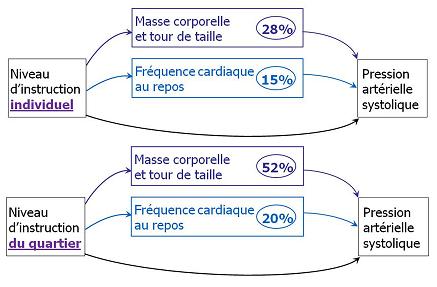 Un objectif de ce travail était d’étudier les disparités de pression artérielle qui existent entre quartier d’Île-de-France. En cohérence avec des résultats connus, nous observons des différences de pression artérielle importantes en fonction du niveau d’instruction des individus, une pression artérielle systolique supérieure de 4 mmHg étant observée pour les personnes ayant un niveau d’instruction égal ou inférieur au BEPC par rapport à celle ayant un niveau d’instruction équivalent ou supérieur à BAC + 2. Par ailleurs, au-delà des effets associés aux caractéristiques socio-économiques individuelles, nous observons que la pression artérielle systolique tend à augmenter à mesure que le niveau socio-économique du quartier de résidence diminue. Comme au niveau individuel, des disparités de pression artérielle plus importantes sont observées entre quartiers lorsque l’on tient compte du niveau d’instruction moyen plutôt que du niveau de revenus moyen des habitants du quartier ou d’autres variables socio-économique. Au-delà des effets associés aux caractéristiques socio-économiques individuelles, si l’on divise les quartiers franciliens de l’étude en quatre classes en fonction de leur niveau d’instruction, on observe que la pression artérielle est supérieure de 0,5 mmHg, 1,3 mmHg et 2,4 mmHg dans les trois groupes de quartiers de plus en plus défavorisés par rapport aux quartiers les plus favorisés.
Au-delà, l’objectif était de s’intéresser aux mécanismes qui pourraient contribuer à ces disparités, en tenant compte d’un certain nombre de facteurs de risque comportementaux, cliniques et biologique d’hypertension artérielle. Ces analyses suggèrent que 28% de la relation entre niveau d’instruction individuel et pression artérielle et près de 52% de la relation entre niveau d’instruction du quartier et pression artérielle étaient dus au poids et au tour de taille plus importants des personnes moins favorisées. Autrement dit, les disparités sociales d’obésité qui existent en Île-de-France entre quartiers sont assez importantes pour donner lieu à des disparités de pression artérielle entre quartiers favorisés et défavorisés, se répercutant ainsi de façon observable sur ce paramètre biologique intime. Par ailleurs, au-delà de l’obésité, nous trouvons qu’une partie non négligeable des différences de pression artérielle entre quartiers semble liée aux écarts de fréquence cardiaque au repos que l’on observe entre quartiers, phénomène que certains auteurs dans la littérature interpréteraient en termes d’exposition plus importante à des facteurs de stress dans les quartiers défavorisés.
Ce travail s’appuyant sur des données transversales (recueillies à un moment unique dans le temps), il convient bien sûr de rester prudent sur les conclusions qu’on en tire.
Un objectif de ce travail était d’étudier les disparités de pression artérielle qui existent entre quartier d’Île-de-France. En cohérence avec des résultats connus, nous observons des différences de pression artérielle importantes en fonction du niveau d’instruction des individus, une pression artérielle systolique supérieure de 4 mmHg étant observée pour les personnes ayant un niveau d’instruction égal ou inférieur au BEPC par rapport à celle ayant un niveau d’instruction équivalent ou supérieur à BAC + 2. Par ailleurs, au-delà des effets associés aux caractéristiques socio-économiques individuelles, nous observons que la pression artérielle systolique tend à augmenter à mesure que le niveau socio-économique du quartier de résidence diminue. Comme au niveau individuel, des disparités de pression artérielle plus importantes sont observées entre quartiers lorsque l’on tient compte du niveau d’instruction moyen plutôt que du niveau de revenus moyen des habitants du quartier ou d’autres variables socio-économique. Au-delà des effets associés aux caractéristiques socio-économiques individuelles, si l’on divise les quartiers franciliens de l’étude en quatre classes en fonction de leur niveau d’instruction, on observe que la pression artérielle est supérieure de 0,5 mmHg, 1,3 mmHg et 2,4 mmHg dans les trois groupes de quartiers de plus en plus défavorisés par rapport aux quartiers les plus favorisés.
Au-delà, l’objectif était de s’intéresser aux mécanismes qui pourraient contribuer à ces disparités, en tenant compte d’un certain nombre de facteurs de risque comportementaux, cliniques et biologique d’hypertension artérielle. Ces analyses suggèrent que 28% de la relation entre niveau d’instruction individuel et pression artérielle et près de 52% de la relation entre niveau d’instruction du quartier et pression artérielle étaient dus au poids et au tour de taille plus importants des personnes moins favorisées. Autrement dit, les disparités sociales d’obésité qui existent en Île-de-France entre quartiers sont assez importantes pour donner lieu à des disparités de pression artérielle entre quartiers favorisés et défavorisés, se répercutant ainsi de façon observable sur ce paramètre biologique intime. Par ailleurs, au-delà de l’obésité, nous trouvons qu’une partie non négligeable des différences de pression artérielle entre quartiers semble liée aux écarts de fréquence cardiaque au repos que l’on observe entre quartiers, phénomène que certains auteurs dans la littérature interpréteraient en termes d’exposition plus importante à des facteurs de stress dans les quartiers défavorisés.
Ce travail s’appuyant sur des données transversales (recueillies à un moment unique dans le temps), il convient bien sûr de rester prudent sur les conclusions qu’on en tire.
http://www.record-study.org/images/record/upload/publications/Hypertension_article.pdf
Les disparités d’obésité en Île-de-France : une influence massive du niveau socio-économique du quartier de résidence
Objectifs de l'étude : Lien vers l'étude concernée
Date de diffusion : 06/2009
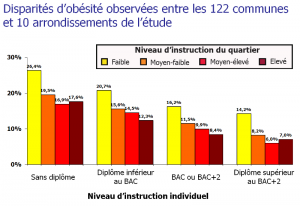 Dans la Cohorte RECORD, 12,4% des participants étaient en situation d’obésité au moment de l’examen. Au-delà de cette valeur moyenne, des différences importantes existent en fonction de la catégorie sociale des individus. Ainsi, le taux d’obésité est tout particulièrement lié au niveau d’instruction des individus (plus encore qu’au revenu), le pourcentage d’obèses étant respectivement de 8%, 12%, 17% et 23% chez les personnes avec un diplôme supérieur à BAC+2, un diplôme entre BAC et BAC+2, un diplôme inférieur au BAC et chez les personnes sans diplôme.
Tout l’objet des travaux de l’équipe est de tenir compte, au-delà des caractéristiques des individus, des caractéristiques de leur quartier de résidence. De même qu’au niveau individuel, le niveau d’instruction des habitants du quartier (proportion des résidents ayant un niveau d’instruction supérieur) semble plus fortement lié au risque d’obésité que le revenu moyen du quartier. Ainsi, le graphique ci-contre suggère que le pourcentage d’individus obèses augmente à la fois lorsque diminue le niveau d’instruction des individus et lorsque diminue le niveau d’instruction moyen de leur quartier de résidence. De façon particulièrement remarquable, des analyses plus précises suggèrent que le niveau d’instruction des individus et le niveau d’instruction moyen de leur quartier de résidence contribuent dans des proportions comparables aux disparités sociales massives d’obésité d’obésité que l’on observe en Île-de-France.
Dans la Cohorte RECORD, 12,4% des participants étaient en situation d’obésité au moment de l’examen. Au-delà de cette valeur moyenne, des différences importantes existent en fonction de la catégorie sociale des individus. Ainsi, le taux d’obésité est tout particulièrement lié au niveau d’instruction des individus (plus encore qu’au revenu), le pourcentage d’obèses étant respectivement de 8%, 12%, 17% et 23% chez les personnes avec un diplôme supérieur à BAC+2, un diplôme entre BAC et BAC+2, un diplôme inférieur au BAC et chez les personnes sans diplôme.
Tout l’objet des travaux de l’équipe est de tenir compte, au-delà des caractéristiques des individus, des caractéristiques de leur quartier de résidence. De même qu’au niveau individuel, le niveau d’instruction des habitants du quartier (proportion des résidents ayant un niveau d’instruction supérieur) semble plus fortement lié au risque d’obésité que le revenu moyen du quartier. Ainsi, le graphique ci-contre suggère que le pourcentage d’individus obèses augmente à la fois lorsque diminue le niveau d’instruction des individus et lorsque diminue le niveau d’instruction moyen de leur quartier de résidence. De façon particulièrement remarquable, des analyses plus précises suggèrent que le niveau d’instruction des individus et le niveau d’instruction moyen de leur quartier de résidence contribuent dans des proportions comparables aux disparités sociales massives d’obésité d’obésité que l’on observe en Île-de-France.
http://www.record-study.org/images/record/upload/Epidemiology_obesity.pdf
Les conditions de vie contrastées des quartiers d’Île-de-France : le quartier comme source de stress ?
Date de diffusion : 06/2009
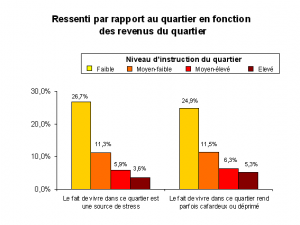 Il semble important, si l’on veut comprendre comment les quartiers de vie et leurs caractéristiques objectives influent sur la santé, de tenir compte des expériences vécues par les résidents au sein de leur quartier. Nous avons donc cherché à voir si les résidents de certains quartiers sont soumis à un cumul d’expériences plus ou moins négatives au sein de leur environnement de résidence.
L’étude réalisée montre que le pourcentage de participants qui déclarent vivre dans un environnement physique dégradé diminue très nettement à mesure qu’augmentent les revenus du quartier. Ainsi, les habitants des quartiers moins favorisés rapportent beaucoup plus souvent un manque d’entretien des équipements collectifs, la présence de détritus dans la rue, des problèmes de vandalisme et des façades d’immeubles du quartier en mauvais état.
Au-delà, il est important de tenir compte, à côté des aspects de l’environnement physique, des relations sociales au sein du quartier. Sur ce plan, les habitants des quartiers défavorisés sont nettement plus nombreux à rapporter des incivilités ou comportements agressifs de personnes de leur quartier, déclarent plus fréquemment avoir été personnellement victime d’une agression physique ou verbale, rapportent beaucoup plus souvent se sentir en insécurité dans leur quartier, et sont également plus nombreux à faire état de conflits de voisinage.
A la fois les situations socio-économiques et ces conditions de vie sont susceptibles de jouer sur le bien-être des personnes. Au total, 12% des participants indiquent que le fait de vivre dans leur quartier est une source de stress pour eux. Toutefois, ainsi que l’indique la figure ci-contre, du groupe des quartiers favorisés aux quartiers les moins favorisés, ce sont 4%, 6%, 11% et 27% des enquêtés qui sont dans cette situation. De même, le pourcentage des participants qui estiment que le fait de vivre dans leur quartier les rend parfois « cafardeux ou déprimés » augmentent très fortement des quartiers les plus favorisés aux quartiers les plus défavorisés. Dans nos prochains travaux, il s’agira de voir si des différences entre quartiers sont également observées lorsque l’on tient compte de véritables indicateurs de mauvaise santé psychologique (par exemple de dépression).
Il semble important, si l’on veut comprendre comment les quartiers de vie et leurs caractéristiques objectives influent sur la santé, de tenir compte des expériences vécues par les résidents au sein de leur quartier. Nous avons donc cherché à voir si les résidents de certains quartiers sont soumis à un cumul d’expériences plus ou moins négatives au sein de leur environnement de résidence.
L’étude réalisée montre que le pourcentage de participants qui déclarent vivre dans un environnement physique dégradé diminue très nettement à mesure qu’augmentent les revenus du quartier. Ainsi, les habitants des quartiers moins favorisés rapportent beaucoup plus souvent un manque d’entretien des équipements collectifs, la présence de détritus dans la rue, des problèmes de vandalisme et des façades d’immeubles du quartier en mauvais état.
Au-delà, il est important de tenir compte, à côté des aspects de l’environnement physique, des relations sociales au sein du quartier. Sur ce plan, les habitants des quartiers défavorisés sont nettement plus nombreux à rapporter des incivilités ou comportements agressifs de personnes de leur quartier, déclarent plus fréquemment avoir été personnellement victime d’une agression physique ou verbale, rapportent beaucoup plus souvent se sentir en insécurité dans leur quartier, et sont également plus nombreux à faire état de conflits de voisinage.
A la fois les situations socio-économiques et ces conditions de vie sont susceptibles de jouer sur le bien-être des personnes. Au total, 12% des participants indiquent que le fait de vivre dans leur quartier est une source de stress pour eux. Toutefois, ainsi que l’indique la figure ci-contre, du groupe des quartiers favorisés aux quartiers les moins favorisés, ce sont 4%, 6%, 11% et 27% des enquêtés qui sont dans cette situation. De même, le pourcentage des participants qui estiment que le fait de vivre dans leur quartier les rend parfois « cafardeux ou déprimés » augmentent très fortement des quartiers les plus favorisés aux quartiers les plus défavorisés. Dans nos prochains travaux, il s’agira de voir si des différences entre quartiers sont également observées lorsque l’on tient compte de véritables indicateurs de mauvaise santé psychologique (par exemple de dépression).







